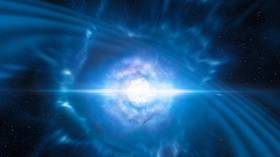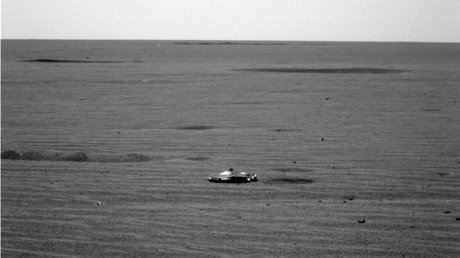Astronomers detect 2nd MASSIVE neutron star collision 520 million light-years away (VIDEOS)

Gravitational wave astronomers, operating at the fringes of our scientific and technological capabilities, have detected a new collision between two neutron stars; just the second time in our history as a species.
Newly published research has revealed that on 25 April 2019 two neutron stars around 520 million light-years away merged into a new object named GW190425, not exactly catchy.
This event marks just the second such collision astronomers have seen; the first was detected back in August 2017, and called GW170817. Again, astrophysicists and astronomers aren’t famed for their ability at coming up with catchy names.
What has scientists really excited about this recent discovery is that it may soon shed light on a “previously undetected type of astrophysical system.”
The difference between these two truly massive moments in scientific history is that during the more recent collision between the two stars of GW190425, there was no light detected.
This is likely because it happened so far away and one of the only instruments we have to detect such events was offline when it happened.
However, as always, science finds a way, and researchers were able to analyze the data and make some conclusions and some inferences, determining that one of the neutron stars in the binary was 1.4 times the mass of the Sun, and the other was around 2 times the mass of the Sun.
“We were very surprised by the total mass of this ancient neutron star binary system, which is about 3.4 times the mass of our Sun, as it far exceeds the mass of known neutron star binaries in our own galaxy,” said theoretical physicist Susan Scott of the Australian National University.
Also on rt.com Astronomers discover most MASSIVE neutron star known to manThis may mean that the previous binary system discovered (GW170817) formed differently than those found in the Milky Way, which may also suggest that similar neutron binaries may not be detectable using current telescopic surveys of the sky.
The collision may also provide new insights into the so-called “mass gap” which sits between neutron stars and black holes, both of which are the ultra dense remains of dead stars. We’ve never observed a black hole smaller than five stellar masses and we’ve also never seen a neutron star larger than 2.5 stellar masses.
Continued study of both the epic objects and the as yet unknown bodies they produced could answer some of the most perplexing questions about this “mass gap.”
Think your friends would be interested? Share this story!














